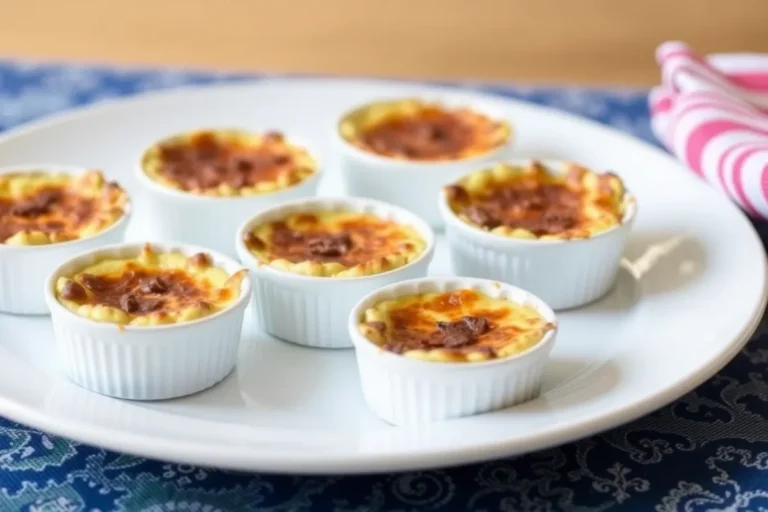Introduction and Essentials
Introduction to Crab Brulee
What is Crab Brulee?
Crab Brulee is a luxurious seafood appetizer that combines the creamy richness of traditional crème brûlée with the delicate, savory flavors of crab. Unlike its dessert counterpart, this dish incorporates seafood and savory ingredients into its custard base, topped with a caramelized layer for an unexpected twist.
This dish is a fusion of gourmet cuisine and comfort food, offering the decadence of fine dining with approachable preparation. The dish is perfect for special occasions or as an indulgent treat for seafood lovers.
Origin and Culinary Context
While the exact origins of Crab Brulee are unclear, it draws heavily from French culinary traditions, specifically the technique used in crème brûlée. This innovative dish has found a place in modern seafood cuisine, celebrated for its unique blend of textures—creamy, flaky, and crunchy.
Why Crab Brulee is a Unique Appetizer
Popularity in Seafood Cuisine
Crab Brulee has gained popularity in high-end restaurants and home kitchens alike due to its versatility and elegance. The combination of fresh crab meat and a lightly sweet, caramelized topping creates a memorable flavor profile. It caters to a growing demand for inventive seafood appetizers that stand out in presentation and taste.
Key Ingredients
Selecting Fresh Crab Meat
Freshness is critical for this recipe. Fresh crab meat not only enhances the dish’s flavor but also ensures its texture remains delicate. When shopping, opt for:
- Lump crab meat for its tenderness.
- Claw meat for a richer, slightly stronger taste.
Avoid canned crab unless no fresh options are available.
Types of Creams for the Recipe
The creamy custard base is central to the dish’s success. Use:
- Heavy cream for a rich, velvety texture.
- Half-and-half for a lighter alternative.
High-quality cream adds to the custard’s smoothness and helps bind the flavors together.
Choosing Complementary Cheeses
The subtle inclusion of cheese enhances the savory depth of the brulee. Recommended options include:
- Gruyère: For its nutty undertones.
- Parmesan: To add sharpness and balance.
- Cream cheese: For extra creaminess.
Seasonings to Enhance Flavor
The seasoning can make or break the dish. Essential options include:
- Cayenne pepper for a slight kick.
- Garlic powder for depth.
- Paprika to enhance the smokiness.
- A dash of lemon zest for a fresh finish.
Essential Equipment
Bakeware Needed: Ramekins
Ramekins are perfect for achieving individual servings and ensuring even cooking. Choose:
- Ceramic or glass ramekins for even heat distribution.
- A size of 4-6 ounces for ideal portioning.
Kitchen Tools for Preparation
Essential tools include:
- Mixing bowls for blending ingredients.
- A whisk for creating a smooth custard base.
- A sieve for straining the mixture to remove lumps.
Torch for Caramelizing the Topping
A culinary torch is indispensable for achieving that classic caramelized crust. It allows precise control over the browning process, ensuring a golden, crunchy finish. If you don’t own one, alternatives include:
- The broiler setting on your oven.
- A heated metal spoon pressed against the sugar topping.
Preparing the Crab Meat
Cleaning and Picking the Crab Meat
The foundation of Crab Brulee lies in the quality of the crab meat. Begin with freshly cooked or pre-steamed crab. Follow these steps:
- Crack the Shell: Use crab crackers or the back of a knife to gently crack open the shell.
- Pick the Meat: Carefully remove the meat from the claws, legs, and body, ensuring there are no shell fragments.
- Rinse Gently: For fresh crab, a quick rinse under cold water removes any residual brine.
Pro Tip: Handle the crab meat gently to preserve its flaky texture.
Types of Crab Suitable for the Recipe
While lump crab meat is preferred, other options include:
- Dungeness crab for a sweet, tender flavor.
- Blue crab for a milder taste.
- King crab if you prefer large, juicy pieces.
Making the Base Mixture
Creating the Creamy Custard Base
The custard forms the heart of the dish. To prepare:
- Whisk the Eggs: Beat 4 large eggs until smooth. The eggs serve as the primary thickener.
- Add Cream: Slowly incorporate 1½ cups of heavy cream or half-and-half.
- Season Generously: Mix in a pinch of salt, ground pepper, garlic powder, and cayenne pepper.
For additional complexity, stir in a teaspoon of Dijon mustard or a splash of sherry.
Mixing Ingredients for Optimal Consistency
For a seamless custard:
- Strain the mixture through a fine sieve to eliminate clumps.
- Gently fold in shredded cheese—Gruyère or Parmesan works best—along with the crab meat.
- Avoid overmixing to retain the crab’s delicate texture.
Layering the Ingredients
Adding Crab Meat to the Custard
Layering ensures that every bite delivers a balanced combination of crab and custard. Here’s how:
- Grease ramekins lightly with butter.
- Place a layer of crab meat at the bottom of each ramekin.
- Pour the custard mixture over the crab, filling the ramekin to about three-quarters full.
Achieving Even Distribution
Distribute the crab evenly across the ramekins to avoid uneven cooking. This ensures every serving looks and tastes consistent.
Cooking Techniques
Baking the Crab Brulee
- Preheat the Oven: Set your oven to 325°F (163°C).
- Prepare a Water Bath: Place the ramekins in a deep baking dish and fill the dish with hot water until it reaches halfway up the ramekins.
- Bake Until Set: Cook for 25-30 minutes, or until the custard is firm but still slightly jiggly in the center.
The water bath prevents the custard from curdling and ensures even cooking.
Broiling for a Perfect Finish
If you don’t have a torch, broiling is a reliable alternative:
- Remove the ramekins from the oven.
- Sprinkle sugar or a savory topping evenly across the surface.
- Broil for 2-3 minutes on high, keeping a close watch to prevent burning.
Topping and Caramelizing
Selecting Sugars or Alternatives for the Topping
The topping adds the final flourish. Options include:
- Brown sugar for a deep caramel flavor.
- Turbinado sugar for a crunchier crust.
- Savory alternatives like grated Parmesan or a mixture of breadcrumbs and butter.
Torch Techniques for a Golden Crust
If using a culinary torch:
- Hold the torch 2-3 inches from the surface.
- Move the flame in small circles to evenly caramelize the sugar.
- Allow the topping to cool and harden before serving.
Tips for Perfection
Avoiding Overcooking
Overcooking can cause the custard to crack or become rubbery. To avoid this:
- Remove the dish from the oven as soon as the edges are set but the center is still slightly wobbly.
- Allow the ramekins to cool for 10 minutes before torching the topping.
Balancing Sweet and Savory Flavors
Striking the right balance is essential:
- Use just enough sugar on the topping to create contrast without overpowering the savory base.
- For a savory-forward dish, reduce the sugar topping and add a pinch of smoked paprika or truffle salt.
Presentation, Variations, and Pairings
Serving Suggestions
Ideal Portions and Serving Styles
Crab Brulee is typically served as an appetizer, making individual ramekins the ideal choice. These small servings are not only visually appealing but also practical for portion control.
- Serve each ramekin warm, straight from the oven, to preserve the creamy texture.
- Garnish with a sprig of fresh herbs, such as parsley or dill, to add a pop of color.
- For a more elevated presentation, place the ramekin on a small plate with a folded napkin beneath to prevent slipping.
Plate Presentation Tips
Enhance the dish’s presentation with these strategies:
- Place a small wedge of lemon on the side for a burst of acidity.
- Add edible flowers or microgreens for a touch of elegance.
- Use a decorative serving tray to present multiple ramekins at a dinner party.
Accompaniments
Suggested Pairings: Wines and Beverages
Pairing the right beverage with Crab Brulee enhances its flavors:
- White Wines: A crisp Sauvignon Blanc or a buttery Chardonnay complements the richness of the dish.
- Champagne: The effervescence cuts through the creaminess, making it a festive choice.
- Cocktails: A citrus-forward cocktail, like a lemon martini or a grapefruit spritz, balances the savory notes.
Ideal Sides: Salads, Crackers, or Breads
Crab Brulee pairs beautifully with light accompaniments:
- Salads: A simple arugula or fennel salad with a citrus vinaigrette adds a refreshing contrast.
- Crackers: Serve with lightly salted crackers or crostini for a crunchy textural element.
- Bread: A slice of toasted baguette or sourdough is perfect for scooping up the creamy custard.
Recipe Variations
Using Lobster or Other Seafood Alternatives
If you’re looking to switch things up, consider substituting crab with other seafood:
- Lobster: Offers a slightly sweeter and more luxurious alternative.
- Shrimp: Adds a firmer texture and a slightly briny flavor.
- Scallops: Provide a delicate sweetness and melt-in-your-mouth consistency.
Incorporating Herbs and Spices
Elevate the flavor profile with additional herbs and spices:
- Tarragon: Complements seafood with its mild licorice flavor.
- Smoked Paprika: Adds a smoky depth to the dish.
- Cilantro: Introduces a bright, citrusy note, especially for tropical variations.
Dietary Modifications
Making a Gluten-Free Version
Crab Brulee is naturally gluten-free, but if incorporating breadcrumbs as a topping, ensure they are gluten-free. Alternatives include:
- Crushed rice crackers.
- Gluten-free panko breadcrumbs.
Adjusting the Recipe for Lactose Intolerance
For a lactose-intolerant version:
- Replace heavy cream with coconut cream or a plant-based alternative like almond milk (unsweetened).
- Use lactose-free cheese or skip the cheese entirely and enhance the seasoning instead.
Storing and Reheating
Proper Storage for Leftovers
Leftover Crab Brulee can be stored for up to 2 days:
- Cover ramekins tightly with plastic wrap or foil.
- Refrigerate immediately after cooling to maintain freshness.
Reheating Without Compromising Texture
Reheating requires care to preserve the dish’s creamy texture:
- Preheat the oven to 300°F (150°C).
- Place the ramekins in a water bath and reheat for 10-15 minutes.
- Avoid using a microwave, as it can make the custard rubbery.
Fun Facts and Trivia
Unique Facts About Brulee Recipes
- The name “brûlée” means “burnt” in French, referencing the caramelized topping.
- Variations of brûlée dishes date back to the 17th century, originating in European culinary traditions.
Crab’s Role in Gourmet Cuisine
- Crab has been a symbol of luxury in seafood cuisine for centuries, often reserved for special occasions.
- Its delicate flavor makes it a versatile ingredient in both savory and sweet culinary creations.
More FAQs:
More FAQs About Crème Brûlée
1. What is the secret to crème brûlée?
The secret to crème brûlée lies in balancing the rich, creamy custard with a perfectly caramelized sugar crust. Using fresh ingredients, a precise baking technique, and proper caramelization are key.
2. What is crème brûlée mostly made of?
Crème brûlée is primarily made of heavy cream, egg yolks, sugar, and vanilla. These simple ingredients come together to create a decadent dessert.
3. What’s the difference between crème brûlée and custard?
While both are custard-based, crème brûlée has a distinct caramelized sugar topping that adds a crunchy texture, whereas regular custard is typically served plain or with a sauce.
4. What type of cream is best for crème brûlée?
Heavy cream is ideal for crème brûlée as it provides the richness and smooth texture that defines the dessert.
5. Can I prepare crème brûlée ahead of time?
Yes! You can prepare the custard mixture and pour it into ramekins up to 24 hours in advance. Refrigerate them, and caramelize the sugar topping just before serving for the best results.
6. Can I freeze crème brûlée?
Freezing crème brûlée is not recommended as it can alter the creamy texture when thawed. It’s best enjoyed fresh or stored in the refrigerator for up to two days.
7. How do I ensure my custard doesn’t crack?
To prevent cracks, bake the custard in a water bath at a low temperature and avoid overcooking. Let it cool gradually after baking.

